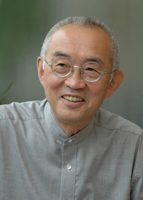“The Emergence of the Demon of Generative AI” Yoshio Tsukio (Professor Emeritus, University of Tokyo)

In March 2022, British Defense Minister Wallace had a 15-minute video conference without realizing that the person he was talking to was a fake Ukrainian Prime Minister Shmyhali.
Furthermore, in June of the same year, Berlin Mayor Gifai held a video conference with Kyiv Mayor Klitschko, but it was only after several minutes of the conversation that he realized that Mayor Klitschko in the video was a fake.
There is a genius who predicted this situation 75 years ago. A. Turing, who graduated from Cambridge University with honors in 1934, worked for an organization opened by the British government in the suburbs of London to decipher the enemy German codes during World War II, and was a scholar who contributed to the analysis of the German Enigma encryption device, which was considered impregnable.
This Turing announced the concept of the Turing test in 1950 after the war. A human and a computer are in a sealed room, and when a question is asked in text form via a communication line from outside, one of them will reply. This theory states that if it is not possible to determine whether the content is from a human or a computer, then the computer has the same intelligence as a human.
At the time, computers had just appeared and could not recognize or synthesize voices, and research into artificial intelligence only began in earnest at the Dartmouth Conference held by several pioneers in 1956, so in 1950 the Turing test was merely a thought experiment. Generative AI emerged as a tangible system.
In March of this year, researchers at the University of California in the United States conducted a Turing test using the latest generative AI, GPT4.5. In this experiment, about 280 students and others were asked questions via keyboard without being informed in advance whether they were artificial intelligence or humans, and the test judged whether the answers were from one of the two sources. As a result, 73% of people were unable to tell.
Since the time of ancient Greece, humans have been trying to create automata, that is, to create clones of themselves and approach the status of gods. In particular, in 18th century Europe, where clock technology developed rapidly, various mechanical automata were produced, and in Japan, wooden clockwork dolls were invented in the Edo period, some of which have been preserved to this day.
These are some of the advances in technology, but technology has both positive and negative sides, as the famous saying goes, a blade can be both a scalpel and a dagger.
During President Trump’s first term, a fake video of former President Obama slandering President Trump was circulated, and in the 2020 election in which President Biden was elected, a large number of synthetic photos were circulated showing that Biden had pedophilic and homosexual tendencies.
These were crude technologies that could easily be detected as fakes, but generative AI can generate extremely sophisticated text and images, and has the built-in ability to easily pass the Turing test. Building a system to maintain the health of an information society in which this demonic technology permeates will be an important and serious challenge in the first half of the 21st century.
※Translating Japanese articles into English with AI
